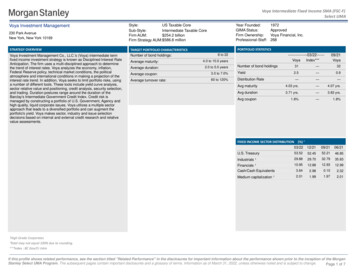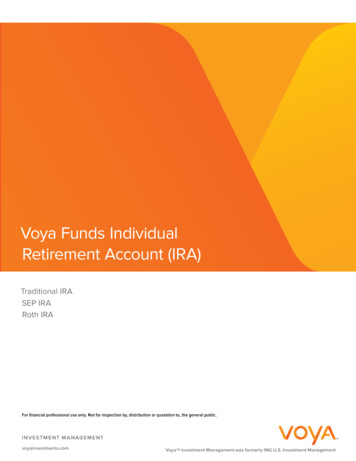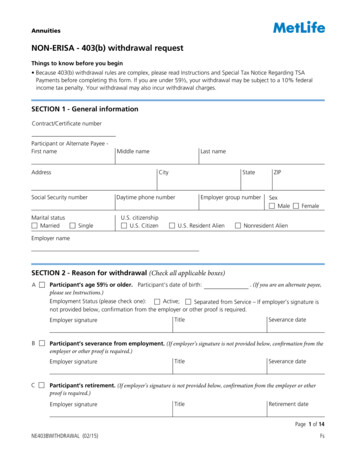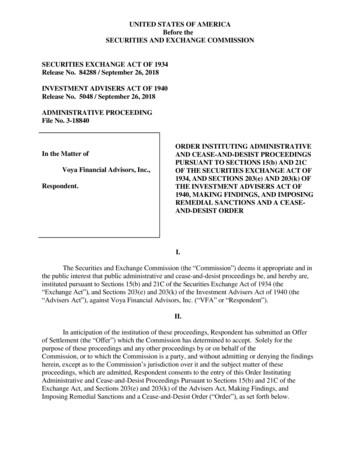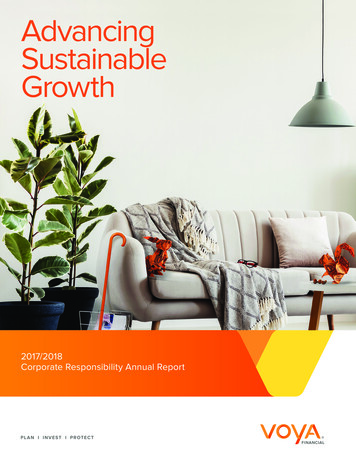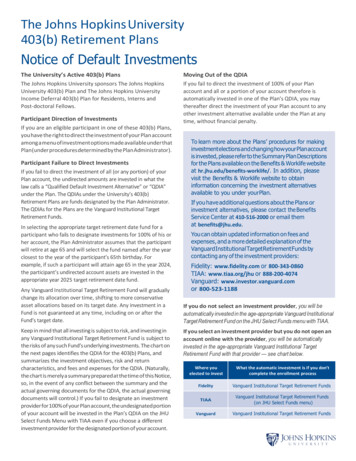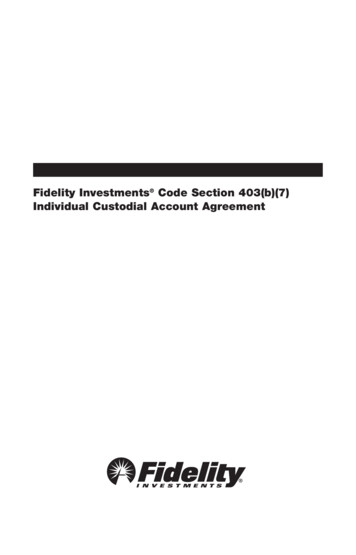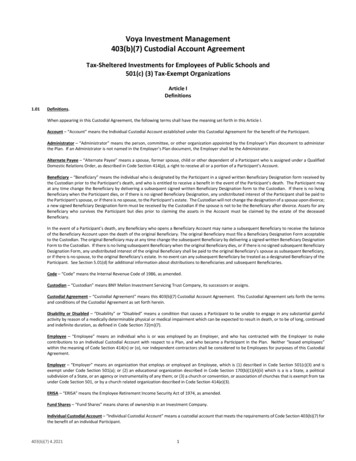
Transcription
Voya Investment Management403(b)(7) Custodial Account AgreementTax-Sheltered Investments for Employees of Public Schools and501(c) (3) Tax-Exempt OrganizationsArticle IDefinitions1.01Definitions.When appearing in this Custodial Agreement, the following terms shall have the meaning set forth in this Article I.Account – “Account” means the Individual Custodial Account established under this Custodial Agreement for the benefit of the Participant.Administrator – “Administrator” means the person, committee, or other organization appointed by the Employer’s Plan document to administerthe Plan. If an Administrator is not named in the Employer’s Plan document, the Employer shall be the Administrator.Alternate Payee – “Alternate Payee” means a spouse, former spouse, child or other dependent of a Participant who is assigned under a QualifiedDomestic Relations Order, as described in Code Section 414(p), a right to receive all or a portion of a Participant’s Account.Beneficiary – “Beneficiary” means the individual who is designated by the Participant in a signed written Beneficiary Designation form received bythe Custodian prior to the Participant’s death, and who is entitled to receive a benefit in the event of the Participant’s death. The Participant mayat any time change the Beneficiary by delivering a subsequent signed written Beneficiary Designation form to the Custodian. If there is no livingBeneficiary when the Participant dies, or if there is no signed Beneficiary Designation, any undistributed interest of the Participant shall be paid tothe Participant’s spouse, or if there is no spouse, to the Participant’s estate. The Custodian will not change the designation of a spouse upon divorce;a new signed Beneficiary Designation form must be received by the Custodian if the spouse is not to be the Beneficiary after divorce. Assets for anyBeneficiary who survives the Participant but dies prior to claiming the assets in the Account must be claimed by the estate of the deceasedBeneficiary.In the event of a Participant’s death, any Beneficiary who opens a Beneficiary Account may name a subsequent Beneficiary to receive the balanceof the Beneficiary Account upon the death of the original Beneficiary. The original Beneficiary must file a Beneficiary Designation Form acceptableto the Custodian. The original Beneficiary may at any time change the subsequent Beneficiary by delivering a signed written Beneficiary DesignationForm to the Custodian. If there is no living subsequent Beneficiary when the original Beneficiary dies, or if there is no signed subsequent BeneficiaryDesignation Form, any undistributed interest of the original Beneficiary shall be paid to the original Beneficiary’s spouse as subsequent Beneficiary,or if there is no spouse, to the original Beneficiary’s estate. In no event can any subsequent Beneficiary be treated as a designated Beneficiary of theParticipant. See Section 5.01(d) for additional information about distributions to Beneficiaries and subsequent Beneficiaries.Code – “Code” means the Internal Revenue Code of 1986, as amended.Custodian – “Custodian” means BNY Mellon Investment Servicing Trust Company, its successors or assigns.Custodial Agreement – “Custodial Agreement” means this 403(b)(7) Custodial Account Agreement. This Custodial Agreement sets forth the termsand conditions of the Custodial Agreement as set forth herein.Disability or Disabled – “Disability” or “Disabled” means a condition that causes a Participant to be unable to engage in any substantial gainfulactivity by reason of a medically determinable physical or medical impairment which can be expected to result in death, or to be of long, continuedand indefinite duration, as defined in Code Section 72(m)(7).Employee – “Employee” means an individual who is or was employed by an Employer, and who has contracted with the Employer to makecontributions to an Individual Custodial Account with respect to a Plan, and who became a Participant in the Plan. Neither “leased employees”within the meaning of Code Section 414(n) or (o), nor independent contractors shall be considered to be Employees for purposes of this CustodialAgreement.Employer – “Employer” means an organization that employs or employed an Employee, which is (1) described in Code Section 501(c)(3) and isexempt under Code Section 501(a); or (2) an educational organization described in Code Section 170(b)(1)(A)(ii) which is a is a State, a politicalsubdivision of a State, or an agency or instrumentality of any them; or (3) a church or convention, or association of churches that is exempt from taxunder Code Section 501, or by a church related organization described in Code Section 414(e)(3).ERISA – “ERISA” means the Employee Retirement Income Security Act of 1974, as amended.Fund Shares – “Fund Shares” means shares of ownership in an Investment Company.Individual Custodial Account – “Individual Custodial Account” means a custodial account that meets the requirements of Code Section 403(b)(7) forthe benefit of an individual Participant.403(b)(7) 4.20211
Instruction – “Instruction” means an instruction to the Custodian that is any oral, written or electronic direction given by a Participant in a form andmanner required or accepted by the Custodian. The Custodian may require that any Instruction be in writing or in an electronic format, and mayrecognize standing requests, directions, or requisitions as Instructions.Investment Company – “Investment Company” means a “regulated investment company” under Code Section 851(a) providing mutual funds underCode Section 403(b)(7) that is selected from time to time by the Sponsor.Participant – “Participant” means an Employee who is a Participant in a Plan.Plan – “Plan” means the plan or arrangement maintained by the Employer and intended to satisfy the requirements of Treasury Regulations Sections1.403(b)-1 through 1.403(b)-11. If there is a conflict between a Plan and this Custodial Agreement, the Plan shall govern. This Custodial Agreementshall not be considered part of a Plan, regardless of whether a Plan incorporates this Custodial Agreement by reference. Effective January 1, 2009,the Employer shall be solely responsible for ensuring that the Plan document constitutes a written plan that, in form and operation, satisfies therequirements of Code Section 403(b).Required Beginning Date –(a)If the Participant attained age 70 ½ in or prior to 2019 (those Participants born on or prior to June 30, 1949) the Required Beginning Date is:the April 1 following the later of the calendar year in which the Participant reaches age 70½, or, if the individual is not a 5% owner, the calendaryear the Participant retires from employment with the Employer.(b)If the Participant attained age 70 ½ in or after 2020 (those Participants born on or after July 1, 1949) the Required Beginning Date is: the April1 following the later of the calendar year in which the Participant reaches age 72, or, if the individual is not a 5% owner, the calendar year theParticipant retires from employment with the Employer.Sponsor – “Sponsor” means the entity with whom the Custodian has entered into a written agreement to offer the Account to Participants.Article IIMaintenance of Custodial Account2.01Establishment of Account.An Account has been established pursuant to this Custodial Agreement for the benefit of the Participant. The Account is intended to be an IndividualCustodial Account that meets the requirements of Code Section 403(b)(7) to hold contributions on behalf of the Participant.2.02Maintenance of Account.The Custodian shall maintain the Account in accordance with the terms of this Custodial Agreement and shall hold and administer the assets in theAccount, including any gains or income from the investment thereof. The Participant shall notify the Custodian in writing of any change in name,address or Social Security number.2.03Nonforfeitable Account.The interest of the Participant in the Account may not be assigned, and shall not be subject to alienation, assignment, process, garnishment,attachment, execution or levy of any kind. The Participant’s interest in the Account shall at all times be non-forfeitable.2.04Exclusive Benefit.At no time shall it be possible for any part of the assets of the Account to be used for or diverted to purposes other than the exclusive purpose ofproviding benefits to the Participant and the Participant’s Beneficiaries and defraying the reasonable expenses of administering the Plan, includingthe Custodian’s expenses. No purported sale, transfer, pledge or assignment by the Participant, his or her spouse, or Beneficiary of all or any partof an interest in the Account shall be recognized by the Custodian. The interest of a Participant, his or her spouse, or a Beneficiary in the Accountshall not be subject to the debt, contracts labilities, engagements or torts of such person or to attachment or legal process against such person,except as permitted or required by law.2.05Contributions.Effective January 1, 2009, Voya Investment Management and BNY Mellon Investment Servicing Trust Company stopped accepting contributions,rollovers or transfers into the Account. The Participant’s existing Account retains its original status, growing tax-deferred until distribution.403(b)(7) 4.20212
Article IIIInvestment of Custodial Account3.01Investment Instructions.The Custodian shall invest the Account in accordance with the Investment Instructions given by the Participant.3.02Investment of Account.The Account shall be invested exclusively in Fund Shares with the Participant as the beneficial owner in accordance with the following provisions:3.03(a)All income dividends and capital gains distributions received on the Fund Shares in the Account shall be reinvested in accordance with theInvestment Company’s then current Prospectus in additional Fund Shares, which shall be credited to the Account.(b)Unless directed otherwise by the Participant, the Custodian shall maintain the investments in the Account as last directed.(c)Participant Instructions shall be communicated in a form and manner required or accepted by the Custodian.(d)The Custodian shall be entitled to rely on any such Instructions supplied by the Participant without being required to verify such Instructions.(e)A confirmation shall be mailed to the Participant or provided electronically with respect to each reinvestment showing the investment thereofand current status of the Custodial Account.Identification of Accounts.All Fund Shares of the Investment Company acquired by the Custodian shall be held in the name of the Custodian or its nominee for the benefit ofthe Participant (or the Beneficiary after the Participant’s death). The Account will not be joined for rights of accumulation with Accounts of otherEmployees of the same Employer.Article IVDistributions/Exchanges/Transfers4.01Request for Distribution.The Participant’s interest in the Account shall be distributed by the Custodian on Instructions, (written or other form as agreed to by the Custodian)from the Participant or his or her Beneficiary, which designate the method of distribution in a form provided in Section 4.04 below. The Custodianmay rely solely on the accuracy of all facts supplied at any time by the Participant or Beneficiary.4.02Timing of Distribution.(a)The Custodian shall distribute, or commence distribution of the balance credited to a Participant’s Account upon receipt of evidencesatisfactory to the Custodian that one or more of the following events has occurred:(1)(2)(3)(4)(4)(5)the Participant’s death;the Participant’s severance from employment;the Participant becomes Disabled;the Participant attains age 59 ½;the Participant’s Financial Hardship;the Participant is called to active duty, as permitted by Code Section 72(t)(2)(G);or(6) the Plan is terminated, provided that the Employer does not make contributions to any 403(b) plan for twelve (12) months followingdistribution of the assets of the Plan, in accordance with Treasury Reg. Section 1.403(b)-10(a)(1).4.03(b)Notwithstanding Section 4.02(a), any amounts contributed to a rollover account prior to January 1, 2009 shall be available for distribution atany time, and shall not be based on the distributable events listed above.(c)Distribution from an Account shall commence within thirty (30) days after the Participant or Beneficiary notifies the Custodian of his or herentitlement to a distribution. Such election shall be made by written notice filed with the Custodian. The Custodian shall not be responsiblefor making any distribution until such time as it has received proper written notification from the Participant, his or her surviving spouse, orthe Beneficiary of the occurrence of an event described in Section 4.02(a).Form of Distribution.The Participant or Beneficiary may elect a form of distribution, in such manner as is acceptable to the Custodian, from among the followingalternatives:(a) a single payment, in cash;403(b)(7) 4.20213
(b) in installments over a period certain, not to exceed a period measured by the life expectancy of the Participant, or the joint life expectanciesof the Participant and the Participant’s Beneficiary; or(c) a combination of (a) and (b).4.04Plan to Plan Transfers from the Account.The Participant may cause the transfer or exchange, in cash, of all or any portion of the balance of the Participant’s Account directly to the custodianof another Individual Custodial Account, or to an insurance company designated by the Participant for the purchase of an annuity contract qualifiedunder Code Section 403(b) if the Administrator certifies that the transaction meets the requirements for a tax-free transfer or exchange underTreasury Reg. Section 1.403(b)-10(b).4.05Direct Rollovers.(a) A Direct Rollover is a payment by a Plan to the Eligible Retirement Plan specified by the Participant. Notwithstanding any provision in anEmployer’s Plan to the contrary, a Participant may elect to have any portion of an Eligible Rollover Distribution paid directly to an EligibleRetirement Plan specified by the Participant in a Direct Rollover. Any such election may be made at a time and in a manner acceptable to theCustodian.(b) Eligible Rollover Distributions: An Eligible Rollover Distribution is any distribution of all or any portion of the Distributee’s Account, except thefollowing:(1) Any distribution that is one of a series of substantially equal periodic payments (not less frequently than annually) made for the life (orlife expectancy) of the Distributee and the Distributee’s Beneficiary, or for a specified period of ten years or more;(2) Any distribution required under Code Section 401(a)(9);(3) Any hardship distribution described in Treasury Notice 2000-32 (and subsequent rulings);(4) Any other distribution that is reasonably expected to total less than 200 during the year(c) Eligible Retirement Plan: Except as noted in subsection 4.6(c)(6), an Eligible Retirement Plan is any of the following that accepts theDistributee’s Eligible Rollover Distribution:(1) An individual retirement account described in Code Section 408(a);(2) A tax sheltered annuity described in Code Section 403(b); and(3) A custodial account described in Code Section 403(b)(7);(4) An eligible plan under Code Section 457(b) that is maintained by a state, political subdivision of a state, or any agency or instrumentalityof a state or political subdivision of a state which agrees to separately account for amounts transferred into such plan from an Accountunder this Custodial Agreement; and(5) A Roth individual retirement account under Code Section 408A(e) where the Direct Rollover is a “qualified rollover contribution” underCode Section 408A(e).(6) For Eligible Rollover Distributions to a surviving spouse, or to a former spouse or Alternate Payee under a Qualified Domestic RelationsOrder under Code Section 414(p), an Eligible Retirement Plan is an individual retirement account or an individual retirement annuity.(d) Distributee. A Distributee includes the following individuals:(1) Employee(2) Former Employee(3) Employee’s or former Employee’s surviving spouse(4) Employee’s or former Employee’s surviving spouse who is an Alternate Payee under a Qualified Domestic Relations Order under CodeSection 414(p)4.06Beneficiary Direct Rollover.(a) A Beneficiary (spouse and non-spouse) may elect a direct trustee-to-trustee transfer of a distribution from an Account to:(1) An individual retirement account described in Code Sections 408(a) or 408(b) that is established for the purpose of receiving thedistribution on behalf of the Beneficiary.403(b)(7) 4.20214
(2) A Roth individual retirement account under Code Section 408A(e) where the distribution is a “qualified rollover contribution” under CodeSection 408A(e).(b) Any such trustee-to-trustee transfer shall be treated as a Direct Rollover of an Eligible Rollover Distribution for purposes of Code Section 402(c).4.07Distributions Under A Qualified Domestic Relations Order.The Custodian will distribute all or a portion of a Participant’s Account to an Alternate Payee under a Qualified Domestic Relations Order thatsatisfies the requirements of Code Section 414(p). The Administrator shall be solely responsible for determining whether a Qualified DomesticRelations Order satisfies the requirements of Code Section 414(p).Article VRequired Minimum Distributions5.01Required Minimum Distributions.(a) Notwithstanding anything in this Custodial Agreement or the Plan to the contrary, distribution of a Participant’s Account shall comply withCode Sections 401(a)(9) and 403(b)(10) the provisions of which, including any subsequent changes, are incorporated by reference into thisCustodial Agreement.(b) The Participant's entire interest in the Custodial Account must be or begin to be, distributed by the Participant's Required Beginning Date, bywhich date, the Participant may elect, in a manner acceptable to the Custodian, to have the balance in the Custodial Account distributed inany of the methods described in Article IV above.(c) Subject to subsection (d) below, the amount of the Required Minimum Distribution for each year is determined by dividing the Participant’saccount balance on December 31 of the prior year by the factor for the Participant’s age on December 31 of the year for which the distributionis made, as shown in the Uniform Lifetime Table in Regulation Section 1.401(a)(9)-9. If the Participant’s spouse is the sole primary beneficiaryof the Participant and the Participant’s spouse is more than 10 years younger than the Participant, the Joint Life and Last Survivor ExpectancyTable from Regulation Section 1.401(a)(9)-9 is used to determine the factor each year. If the Participant dies prior to receiving his or her entireAccount balance, the rules in subsection (d) will apply.(d) Distributions Due to Death of Participant(1) Distributions Due to Death of Participant on or Prior to December 31, 2019.(A) Death Before Required Beginning Date. If, prior to the Participant’s death, the Participant has not started to take his or her RequiredMinimum Distributions and the Participant has properly designated a beneficiary(ies), the entire value of the Participant’s Accountmust be distributed to the Participant’s beneficiaries within five years after the Participant’s death, unless the designated beneficiaryelects in writing, no later than September 30th of the year following the year in which the Participant dies, to take distributions overhis or her life expectancy. These distributions must commence no later than December 31st of the calendar year following the calendaryear of the Participant’s death. However, if the Participant’s spouse is the Participant’s sole beneficiary, these distributions are notrequired to commence until the December 31st of the calendar year the Participant would have attained age 70½, if that date is laterthan the required commencement date in the previous sentence. If the Participant dies before his or her Required Beginning Date andthe Participant does not have a designated beneficiary, the balance in the Participant’s Account must be distributed no later than theDecember 31st of the calendar year that contains the fifth anniversary of the Participant’s death.(B) Death After Required Beginning Date. If the Participant dies on or after his or her Required Beginning Date and the Participant has adesignated beneficiary, the balance in the Participant’s Account will be distributed to his or her beneficiary over a period not longerthan the beneficiary's single life expectancy. These distributions must commence no later than December 31st of the calendar yearfollowing the calendar year of the Participant’s death. If the Participant dies on or after his or her Required Beginning Date and theParticipant does not have a designated beneficiary, the balance in the Participant’s Account must be distributed over a period thatdoes not exceed his or her remaining single life expectancy determined in the year of the Participant’s death. However, the RequiredMinimum Distribution for the calendar year that contains the date of the Participant’s death is still required to be distributed. Suchamount is determined as if the Participant were still alive throughout that year. If the Participant’s spouse is his or her sole beneficiary,the spouse may elect to treat the Participant’s Account as his or her own Account, whether the Participant dies before or after his orher Required Beginning Date. If the Participant dies after his or her Required Beginning Date and his or her spouse elects to treat theParticipant’s Account as his or her own Account, any Required Minimum Distribution that has not been distributed for the year of theParticipant’s death must still be distributed to his or her surviving spouse and then the remaining balance can be treated as thespouse's own Account. After the Participant’s death, his or her designated beneficiary may name a subsequent beneficiary. Anysubsequent beneficiaries must take distributions at least as frequently as the original designated beneficiary, provided the originalbeneficiary’s date of death is on or prior to December 31, 2019. If the Participant does not properly designate a beneficiary, or alldesignated beneficiaries have predeceased the Participant, his or her spouse shall become the beneficiary or, if no surviving spouseor unmarried, the distribution will be made to the Participant’s estate.(2) Distributions Due to Death of a Participant On or After January 1, 2020.403(b)(7) 4.20215
(A) If the Participant dies on or after his or her Required Beginning Date the Required Minimum Distribution for the year of his or herdeath must be distributed to the Participant’s beneficiary(ies) if it has not otherwise been taken prior to the date of the Participant’sdeath.(B) If the Participant has no designated Beneficiary on September 30 of the year following the year in which the Participant dies, the entirevalue of the Participant’s Account must be distributed to his or her beneficiaries by December 31 of the calendar year that containsthe fifth anniversary of the Participant’s death.(C) If the Participant has one or more properly designated beneficiaries, all amounts remaining in the Participant’s Account upon his orher death must be distributed no later than December 31 of the calendar year that contains the tenth anniversary of the Participant’sdeath. An exception to the 10-year rule is available for “eligible designated beneficiaries” who elect in writing no later than December31 of the year after the Participant’s death to take distributions over their life expectancy.(D) An “eligible designated beneficiary” is any designated beneficiary named by the Participant where such designation is received inproper form prior to the death of the Participant and the designated beneficiary is:(i)The Participant’s spouse; if the Participant’s designated beneficiary is his or her spouse, the spouse may elect to treat theParticipant’s account as their own.(ii)A child of the Participant who has not reached the age of majority for the state in which the minor resides. Upon attainingthe age of majority, the child of the Participant will no longer be an “eligible designated beneficiary”. Any portion remainingmust be distributed no later than the end of the tenth year after the year the child reaches majority.(iii)Disabled individuals within the meaning of Code Section 72(m)(7) as of the date of the death of the Participant.(iv)Chronically ill individuals, within the meaning of Code Section 72(m)(7) as of the date of the death of the Participant.(v)An individual not listed above who is not more than 10 years younger than the Participant.(E) After the Participant’s death, his or her designated Beneficiary including an ‘eligible designated beneficiary’ who establishes aBeneficiary Account, may name a subsequent Beneficiary in accordance with the following rules:(i)(ii)Upon the death of the Participant’s designated Beneficiary (i.e., the original Beneficiary), if no subsequent Beneficiarysurvives the original Beneficiary then:(1)if the original Beneficiary was married, the original Beneficiary’s spouse is the subsequent Beneficiary;(2)if the original Beneficiary was not married on the date of the original Beneficiary’s death, the assets shall passto the original Beneficiary’s estate.A subsequent Beneficiary is not eligible to take life expectancy distributions.(iii) Subsequent Beneficiaries who are non-designated Beneficiaries should consult with a tax professional regarding when theAccount must be distributed.(iv) A subsequent Beneficiary who is a designated Beneficiary is subject to the ’10-year rule’ as follows:5.02(1)A subsequent Beneficiary of an “eligible designated beneficiary” has until December 31 of the calendar year thatcontains the tenth anniversary of the death of the Participant’s ‘eligible designated beneficiary’ to distribute all assetsin the Account;(2)A subsequent Beneficiary of a designated Beneficiary who is NOT an ‘eligible designated beneficiary’ has untilDecember 31 of the calendar year that contains the tenth anniversary of the death of the Participant to distribute allassets in the Account.Instructions for Required Minimum Distributions.The Custodian shall make Required Minimum Distributions under this Article V only upon the Instruction of the Participant. The Custodian shallnot be responsible for determining the timing or amount of any Required Minimum Distribution. The Custodian will calculate the RequiredMinimum Distribution at the request of the Participant, based upon information supplied by the Participant, and shall have no duty or responsibilityto verify the accuracy of any information supplied by the Participant.Article VILoans6.01Loans. Loans are not permitted.403(b)(7) 4.20216
Article VIIHardship Distributions7.01Hardship Distributions Permitted.(a) To the extent permitted by the Employer’s Plan, a distribution may be made to a Participant in the event of a Financial Hardship.(b) In processing any withdrawal request, the Custodian shall be fully entitled to rely on the Instructions furnished or certifications made by theParticipant, and shall be under no duty to make any inquiry or investigation with respect thereto.7.02Financial Hardship.(a) A Financial Hardship distribution may only be made on account of an immediate and heavy financial need of the Participant, and where thedistribution is necessary to satisfy the immediate and heavy financial need. A Financial Hardship distribution will only be considered asnecessary to satisfy an immediate and heavy financial need of the Participant if the distribution is not in excess of the amount of the immediateand heavy financial need (including amounts necessary to pay any federal, state or local income taxes or penalties reasonably anticipated toresult from the distribution);(b) Financial Hardship shall be determined in accordance with Code Section 403(b), and the regulations thereunder, and the Employer’s orCustodian’s hardship policy and procedures, if applicable. The following are the only financial needs considered immediate and heavy:(1)expenses incurred (or necessary to obtain) for medical care that would be deductible under Code Section 213(d), determined withoutregard to the limitations in Code Section 213(a) (relating to the applicable percentage of adjusted gross income and the recipients of themedical care) provided that, if the recipient of the medical care is not listed in Code Section 213(a), the recipient is a primary beneficiaryunder the Plan (as that term is defined in Treas. Reg. 1 401(k)-1(d)(3)(ii)(C);(2)costs directly related to the purchase (excluding mortgage payments) of a principal residence for the Participant;(3)payment of tuition and related educational fees for the next twelve (12) months of post-secondary education for the Participant, theParticipant’s spouse, children or dependents, or the Participant’s primary beneficiary;(4)payment necessary to prevent the eviction of the Participant from, or a foreclosure on the mortgage of, the Participant’s principalresidence;(5)payments for funeral or burial expenses for the Participant’s deceased parent, spouse, child or dependent, or the Participant’s primarybeneficiary;(6)expenses to repair damage to the Participant’s principal residence that would qualify for a casualty loss deduction under Code Section165 (determined without regard to whether the loss exceeds ten percent (10%) of adjusted gross income; and(7)expenses and losses, including loss of income, incurred by the Participant on account of a disaster declared by the Federal EmergencyManagement Agency (FEMA), provided that the Participant’s principal residence or principal place of employment at the time of thedisaster was located in an area designated by FEMA for individual assistance with respect to the disaster.Article VIIIAdministration
Custodian - "Custodian" means BNY Mellon Investment Servicing Trust Company, its successors or assigns. Custodial Agreement - "Custodial Agreement" means this 403(b)(7) Custodial Account Agreement. This Custodial Agreement sets forth the terms and conditions of the Custodial Agreement as set forth herein. Disability or Disabled -

